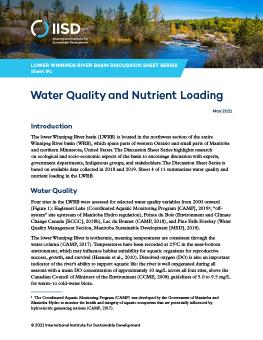
Lower Winnipeg River Basin Discussion Sheet Series Sheet #4 | Water Quality and Nutrient Loading
-
The Winnipeg River is the second-largest contributor of nutrients (in absolute terms) to Lake Winnipeg.
-
The potential impact of metal exceedances on aquatic life in the lower Winnipeg River is unknown, as are the major source contributors.
-
Four sites on the lower Winnipeg River basin are monitored by three organizations using different analytical methods and sampling periods.
The lower Winnipeg River basin (LWRB) is located in the northwest section of the entire Winnipeg River basin (WRB), which spans parts of western Ontario and small parts of Manitoba and northern Minnesota, United States. The Discussion Sheet Series highlights research on ecological and socio-economic aspects of the basin to encourage discussion with experts, government departments, Indigenous groups, and stakeholders. The Discussion Sheet Series is based on available data collected in 2018 and 2019. Sheet 4 of 11 summarizes water quality and nutrient loading in the LWRB
Participating experts
You might also be interested in
INC-4 Is an Opportunity to Address Fresh Water Pollution – This is how
INC-4 is the fourth meeting in a series of international negotiations that aims to develop a global treaty on plastic pollution that could and should have big implications for freshwater quality both in Canada and beyond.
Northwest Ontario Side Story: IISD Experimental Lakes Area Annual Report 2022-2023
This year's annual report is a celebration of all things creative at the world's freshwater laboratory, from the science to music, photography and theatre.
Why Liquefied Natural Gas Expansion in Canada Is Not Worth the Risk
An analysis of the economic and environmental risks of liquified natural gas expansion in Canada.
New Report Highlights Economic and Environmental Costs of Canada’s LNG Expansion
New report explains how LNG expansion will not only hamper Canada’s progress toward its climate goals but also create challenges for the economy in the long term.